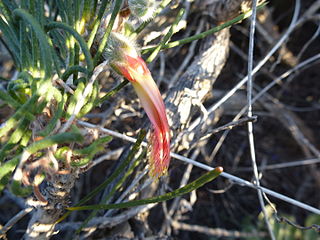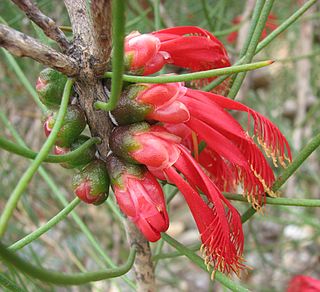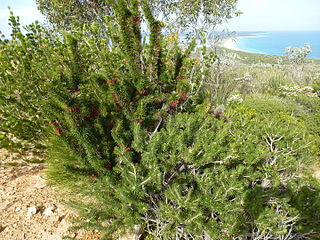
Calothamnus chrysanthereus , commonly known as claw flower is a plant in the myrtle family, Myrtaceae and is endemic to the south-west of Western Australia. It is an erect shrub with needle-shaped leaves crowded on the ends of the branches and bright red flowers in spring.

Calothamnus gilesii is a plant in the myrtle family, Myrtaceae and is endemic to the south-west of Western Australia. It is an erect, usually compact shrub with fine, pine-like foliage and which produces cluster of red flowers from June to January.

Calothamnus pinifolius, commonly known as dense clawflower, is a plant in the myrtle family, Myrtaceae and is endemic to the south-west of Western Australia. It is an erect shrub with dense foliage and clusters of red flowers, partly immersed in the prickly foliage, between July and January.
Calothamnus borealis is a plant in the myrtle family, Myrtaceae and is endemic to the south-west of Western Australia. It is a small, erect shrub with crowded, cylindrical leaves and red flowers. It grows in sand surrounded by spinifex or heath. In 2014 Craven, Edwards and Cowley proposed that the species be renamed Melaleuca aquilonia.
Calothamnus cupularis is a plant in the myrtle family, Myrtaceae and is endemic to the south-west of Western Australia. It is a similar shrub to Calothamnus formosus but has larger flowers and fruit.

Calothamnus gibbosus, commonly known as corky net-bush, is a plant in the myrtle family, Myrtaceae and is endemic to the south-west of Western Australia. Its distinguishing characteristic is its corky bark in which the hypanthium of the flowers and much of the fruits is buried. Only the petals and stamens emerge from the bark.
Calothamnus glaber is a plant in the myrtle family, Myrtaceae and is endemic to near-coastal areas in the south-west of Western Australia. It is a shrub, similar to Calothamnus blepharospermus but its leaves are slightly longer and narrower and the parts of its flowers are glabrous.
Calothamnus gracilis is a plant in the myrtle family, Myrtaceae and is endemic to the south-west of Western Australia. It is a spreading shrub with upright foliage, common in heath within its range. It has long, thin leaves and produces dark red flowers at different times of the year, depending partly on rainfall. It is similar to Calothamnus gibbosus but lacks the corky bark on the older branches of that species and its flowers and fruit are not as deeply embedded in the bark.
Calothamnus huegelii is a plant in the myrtle family, Myrtaceae and is endemic to the south-west of Western Australia. It is an erect shrub growing to a height of about 2 metres (6.6 ft) with red flowers in autumn or September.
Calothamnus lehmannii, commonly known as dwarf claw flower, is a plant in the myrtle family, Myrtaceae and is endemic to the south-west of Western Australia. It is a low-lying, sometimes ground-hugging shrub with long, thin, cylindrical leaves and clusters of red flowers that are smaller than any others in the genus Calothamnus.

Calothamnus longissimus is a plant in the myrtle family, Myrtaceae and is endemic to the south-west of Western Australia. It is a small, spreading shrub with unusually long, fine leaves and which produces clusters of red flowers in spring.
Calothamnus macrocarpus is a plant in the myrtle family, Myrtaceae and is endemic to the south-west of Western Australia. It is an erect shrub with bright red flowers in spring and large, almost spherical fruit. It has a limited distribution near Hopetoun.
Calothamnus microcarpus is a plant in the myrtle family, Myrtaceae and is endemic to the south-west of Western Australia. It is an erect, either compact or spreading shrub with flat leaves and clusters of red flowers in spring.
Calothamnus oldfieldii is a plant in the myrtle family, Myrtaceae and is endemic to the south-west of Western Australia. It is a small, spreading shrub with needle-shaped leaves and clusters of red flowers with 5 petals and 5 stamen bundles.

Calothamnus pachystachyus is a plant in the myrtle family, Myrtaceae and is endemic to the south-west of Western Australia. It is an erect, much-branched shrub with thick bark, flat leaves and clusters of red flowers in spring.

Calothamnus planifolius is a plant in the myrtle family, Myrtaceae and is endemic to the south-west of Western Australia. It is an erect shrub with many branches, growing to a height of about 1.5 metres (4.9 ft) with flat leaves and red flowers from September to November. The flowers have 4 petals and 4 narrow bundles of stamens.

Calothamnus preissii is a plant in the myrtle family, Myrtaceae and is endemic to the south-west of Western Australia. It is a low-lying, sometimes ground-hugging shrub with needle-like leaves and reddish-purple flowers in spring.
Calothamnus schaueri is a plant in the myrtle family, Myrtaceae and is endemic to the south-west of Western Australia. It is a small, spreading, sometimes prostrate shrub, growing to a height of about 0.6 metres (2 ft) with cylindrical leaves 100–200 millimetres (4–8 in) long. It has brownish red flowers from August to December. The flowers have 4 petals and 4 narrow bundles of stamens.
Calothamnus superbus is a plant in the myrtle family, Myrtaceae and is endemic to the south-west of Western Australia. It is an erect, often spreading, straggly shrub similar to Calothamnus aridus with its red flowers having 5 stamen bundles, but its leaves are longer and wider. It has a limited distribution near Pigeon Rocks south of Lake Barlee.

Calothamnus tuberosus is a plant in the myrtle family, Myrtaceae and is endemic to the south-west of Western Australia. It is a stiff, prickly plant with cylindrical leaves and red flowers, growing near or often on granite boulders. It has a lignotuber and tuberous roots.








